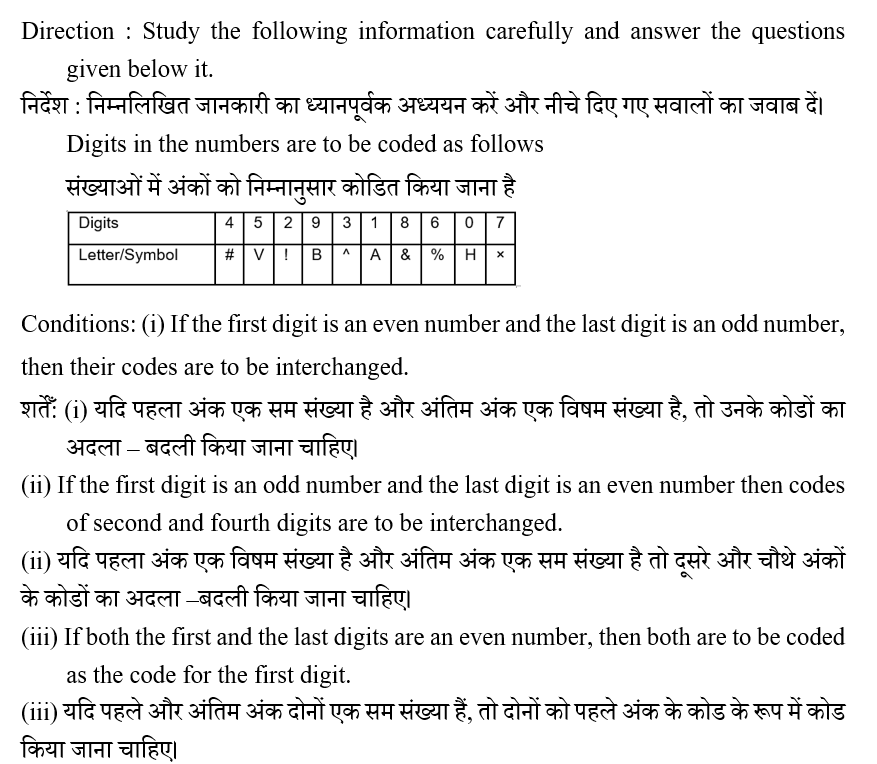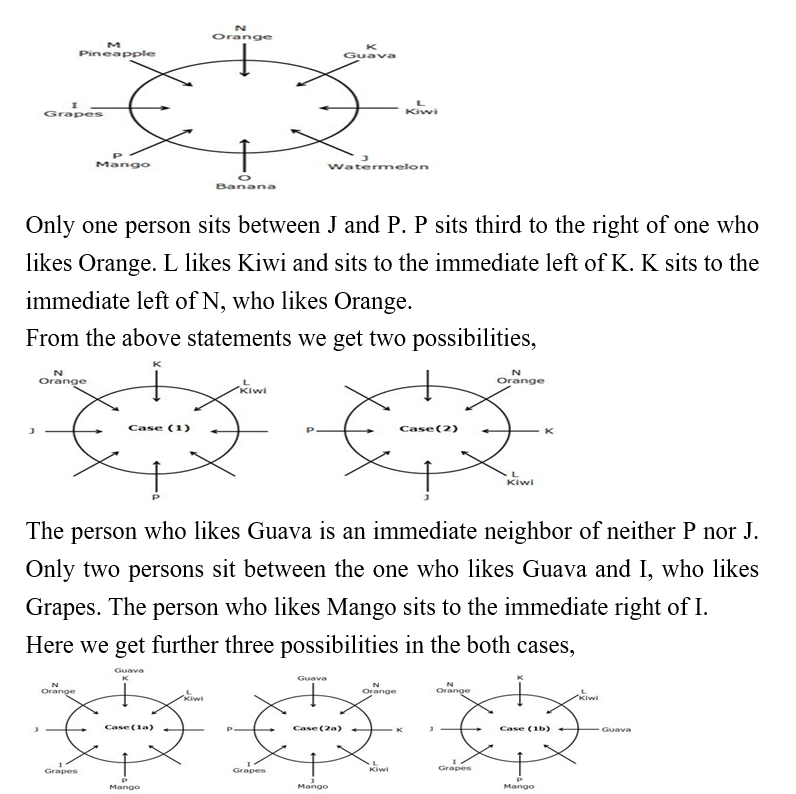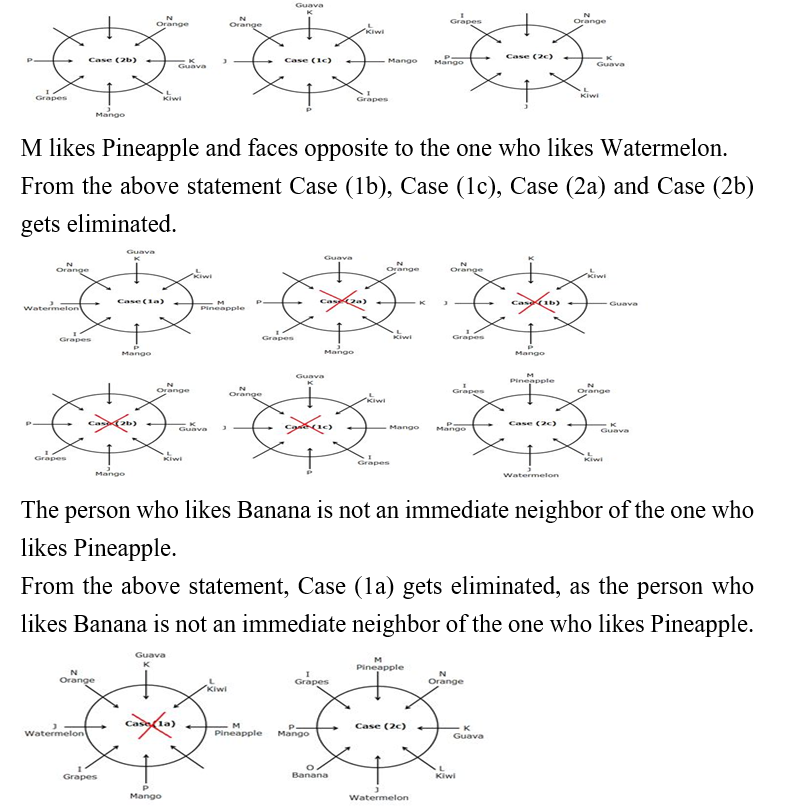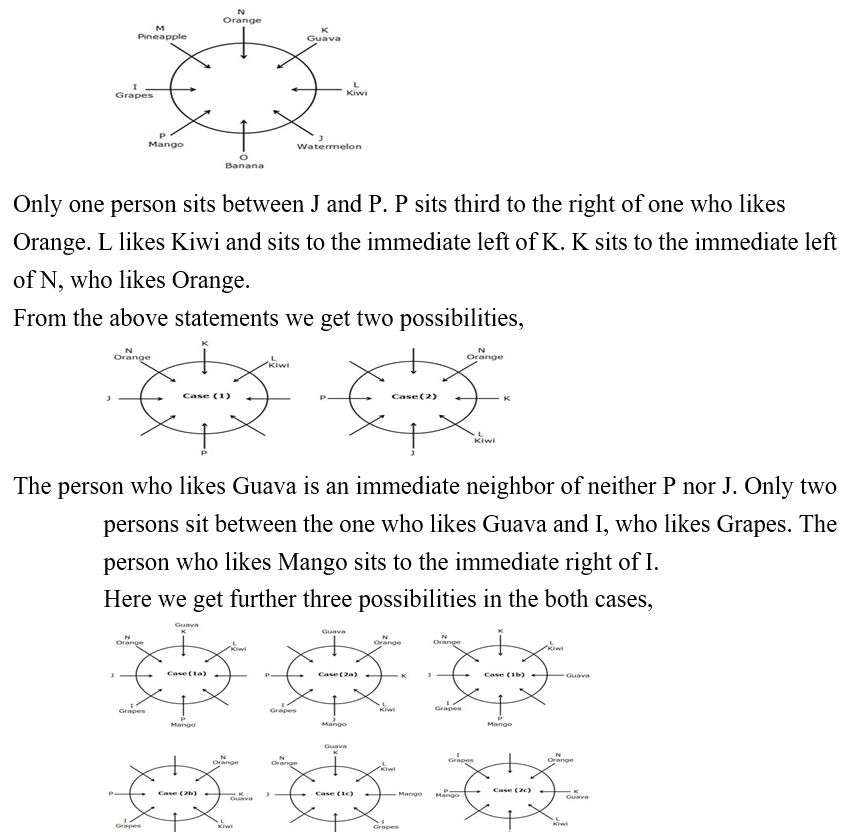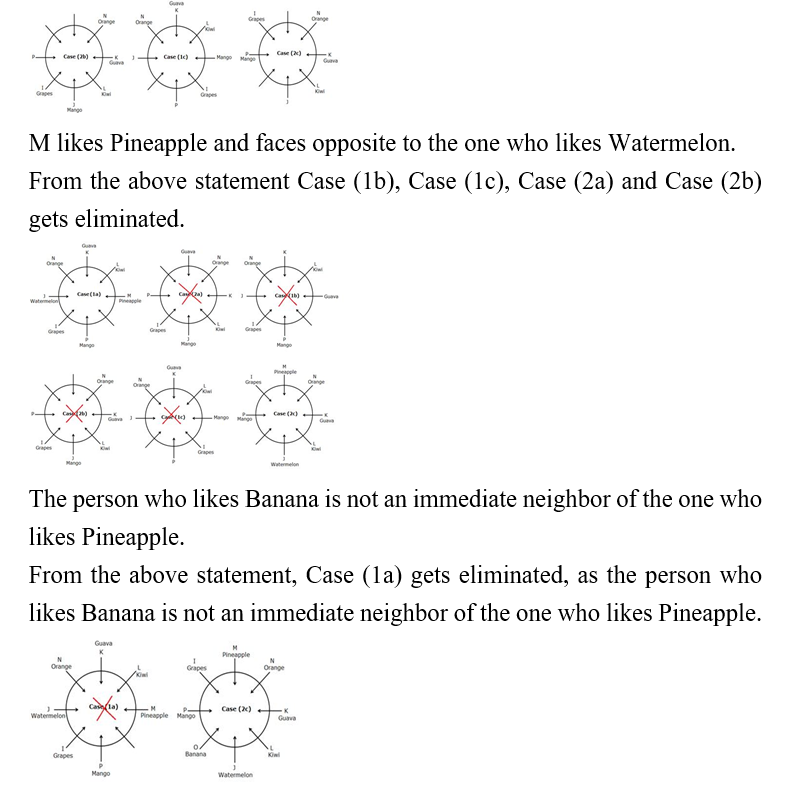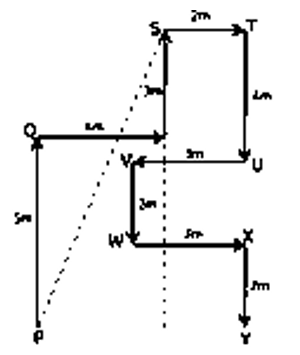Question 1:
Direction : Study the following information carefully and answer the below questions.
निर्देश : निम्नलिखित जानकारी सावधानी से पढ़ें और नीचे दिए गए प्रश्नों का उत्तर दें।
There are eight people namely – P, L, M, O, K, N, I and J sitting in a circular table facing towards the centre. Each likes different fruits viz. Mango, Pineapple, Orange, Banana, Grapes, Guava, Watermelon and Kiwi. All the information is not necessary to be in the same order.
Only one person sits between J and P. P sits third to the right of one who likes Orange. The person who likes Guava is an immediate neighbor of neither P nor J. Only two persons sit between the one who likes Guava and I, who likes Grapes. L likes Kiwi and sits to the immediate left of K. K sits to the immediate left of N, who likes Orange. M likes Pineapple and faces opposite to the one who likes Watermelon. The person who likes Mango sits to the immediate right of I. The person who likes Banana is not an immediate neighbor of the one who likes Pineapple.
आठ लोग अर्थात् P, L, M, O, K, N, I और J केंद्र की ओर मुख करके एक वृत्ताकार टेबल में बैठे हैं। प्रत्येक को विभिन्न फल पसंद हैं जैसे आम, अनानस, नारंगी, केला, अंगूर, अमरूद, तरबूज और कीवी। जरूरी नहीं कि सभी जानकारी उसी क्रम में है।
J और P के बीच केवल एक व्यक्ति बैठता है। P, नारंगी पसंद करने वाले व्यक्ति के दाईं ओर तीसरे स्थान पर बैठता है। अमरूद पसंद करने वाला व्यक्ति न तो P और न ही J का निकटतम पड़ोसी है। अमरूद पसंद करने वाले व्यक्ति और I के बीच केवल दो व्यक्ति बैठते हैं, जो अंगूर पसंद करता है। L, कीवी पसंद करता है और K के तुरंत बाईं ओर बैठता है। K, N के तुरंत बाईं ओर बैठता है, जो नारंगी पसंद करता है। M, अनानास पसंद करता है और तरबूज पसंद करने वाले व्यक्ति के विपरीत मुख करता है। आम पसंद करने वाला व्यक्ति, I के तुरंत दाईं ओर बैठता है। केला पसंद करने वाला व्यक्ति, अनानास पसंद करने वाले व्यक्ति का निकटतम पड़ोसी नहीं है।
Who sits to the immediate right of P?
P के तुरंत दाईं ओर कौन बैठता है?
Question 2:
Direction : Study the following information carefully and answer the below questions.
निर्देश : निम्नलिखित जानकारी सावधानी से पढ़ें और नीचे दिए गए प्रश्नों का उत्तर दें।
There are eight people namely – P, L, M, O, K, N, I and J sitting in a circular table facing towards the centre. Each likes different fruits viz. Mango, Pineapple, Orange, Banana, Grapes, Guava, Watermelon and Kiwi. All the information is not necessary to be in the same order.
Only one person sits between J and P. P sits third to the right of one who likes Orange. The person who likes Guava is an immediate neighbor of neither P nor J. Only two persons sit between the one who likes Guava and I, who likes Grapes. L likes Kiwi and sits to the immediate left of K. K sits to the immediate left of N, who likes Orange. M likes Pineapple and faces opposite to the one who likes Watermelon. The person who likes Mango sits to the immediate right of I. The person who likes Banana is not an immediate neighbor of the one who likes Pineapple.
आठ लोग अर्थात् P, L, M, O, K, N, I और J केंद्र की ओर मुख करके एक वृत्ताकार टेबल में बैठे हैं। प्रत्येक को विभिन्न फल पसंद हैं जैसे आम, अनानस, नारंगी, केला, अंगूर, अमरूद, तरबूज और कीवी। जरूरी नहीं कि सभी जानकारी उसी क्रम में है।
J और P के बीच केवल एक व्यक्ति बैठता है। P, नारंगी पसंद करने वाले व्यक्ति के दाईं ओर तीसरे स्थान पर बैठता है। अमरूद पसंद करने वाला व्यक्ति न तो P और न ही J का निकटतम पड़ोसी है। अमरूद पसंद करने वाले व्यक्ति और I के बीच केवल दो व्यक्ति बैठते हैं, जो अंगूर पसंद करता है। L, कीवी पसंद करता है और K के तुरंत बाईं ओर बैठता है। K, N के तुरंत बाईं ओर बैठता है, जो नारंगी पसंद करता है। M, अनानास पसंद करता है और तरबूज पसंद करने वाले व्यक्ति के विपरीत मुख करता है। आम पसंद करने वाला व्यक्ति, I के तुरंत दाईं ओर बैठता है। केला पसंद करने वाला व्यक्ति, अनानास पसंद करने वाले व्यक्ति का निकटतम पड़ोसी नहीं है।
How many persons are sitting between M and L, when counted from L in anticlockwise direction?
M और L के बीच कितने लोग बैठे हैं, जब L से घड़ी की विपरीत दिशा में गिना जाता है?
Question 3:
Direction : Study the following information carefully and answer the below questions.
निर्देश : निम्नलिखित जानकारी सावधानी से पढ़ें और नीचे दिए गए प्रश्नों का उत्तर दें।
There are eight people namely – P, L, M, O, K, N, I and J sitting in a circular table facing towards the centre. Each likes different fruits viz. Mango, Pineapple, Orange, Banana, Grapes, Guava, Watermelon and Kiwi. All the information is not necessary to be in the same order.
Only one person sits between J and P. P sits third to the right of one who likes Orange. The person who likes Guava is an immediate neighbor of neither P nor J. Only two persons sit between the one who likes Guava and I, who likes Grapes. L likes Kiwi and sits to the immediate left of K. K sits to the immediate left of N, who likes Orange. M likes Pineapple and faces opposite to the one who likes Watermelon. The person who likes Mango sits to the immediate right of I. The person who likes Banana is not an immediate neighbor of the one who likes Pineapple.
आठ लोग अर्थात् P, L, M, O, K, N, I और J केंद्र की ओर मुख करके एक वृत्ताकार टेबल में बैठे हैं। प्रत्येक को विभिन्न फल पसंद हैं जैसे आम, अनानस, नारंगी, केला, अंगूर, अमरूद, तरबूज और कीवी। जरूरी नहीं कि सभी जानकारी उसी क्रम में है।
J और P के बीच केवल एक व्यक्ति बैठता है। P, नारंगी पसंद करने वाले व्यक्ति के दाईं ओर तीसरे स्थान पर बैठता है। अमरूद पसंद करने वाला व्यक्ति न तो P और न ही J का निकटतम पड़ोसी है। अमरूद पसंद करने वाले व्यक्ति और I के बीच केवल दो व्यक्ति बैठते हैं, जो अंगूर पसंद करता है। L, कीवी पसंद करता है और K के तुरंत बाईं ओर बैठता है। K, N के तुरंत बाईं ओर बैठता है, जो नारंगी पसंद करता है। M, अनानास पसंद करता है और तरबूज पसंद करने वाले व्यक्ति के विपरीत मुख करता है। आम पसंद करने वाला व्यक्ति, I के तुरंत दाईं ओर बैठता है। केला पसंद करने वाला व्यक्ति, अनानास पसंद करने वाले व्यक्ति का निकटतम पड़ोसी नहीं है।
Who among the following likes Guava?
निम्नलिखित में से कौन अमरूद पसंद करता है?
Question 4:
Direction : Study the following information carefully and answer the below questions.
निर्देश : निम्नलिखित जानकारी सावधानी से पढ़ें और नीचे दिए गए प्रश्नों का उत्तर दें।
There are eight people namely – P, L, M, O, K, N, I and J sitting in a circular table facing towards the centre. Each likes different fruits viz. Mango, Pineapple, Orange, Banana, Grapes, Guava, Watermelon and Kiwi. All the information is not necessary to be in the same order.
Only one person sits between J and P. P sits third to the right of one who likes Orange. The person who likes Guava is an immediate neighbor of neither P nor J. Only two persons sit between the one who likes Guava and I, who likes Grapes. L likes Kiwi and sits to the immediate left of K. K sits to the immediate left of N, who likes Orange. M likes Pineapple and faces opposite to the one who likes Watermelon. The person who likes Mango sits to the immediate right of I. The person who likes Banana is not an immediate neighbor of the one who likes Pineapple.
आठ लोग अर्थात् P, L, M, O, K, N, I और J केंद्र की ओर मुख करके एक वृत्ताकार टेबल में बैठे हैं। प्रत्येक को विभिन्न फल पसंद हैं जैसे आम, अनानस, नारंगी, केला, अंगूर, अमरूद, तरबूज और कीवी। जरूरी नहीं कि सभी जानकारी उसी क्रम में है।
J और P के बीच केवल एक व्यक्ति बैठता है। P, नारंगी पसंद करने वाले व्यक्ति के दाईं ओर तीसरे स्थान पर बैठता है। अमरूद पसंद करने वाला व्यक्ति न तो P और न ही J का निकटतम पड़ोसी है। अमरूद पसंद करने वाले व्यक्ति और I के बीच केवल दो व्यक्ति बैठते हैं, जो अंगूर पसंद करता है। L, कीवी पसंद करता है और K के तुरंत बाईं ओर बैठता है। K, N के तुरंत बाईं ओर बैठता है, जो नारंगी पसंद करता है। M, अनानास पसंद करता है और तरबूज पसंद करने वाले व्यक्ति के विपरीत मुख करता है। आम पसंद करने वाला व्यक्ति, I के तुरंत दाईं ओर बैठता है। केला पसंद करने वाला व्यक्ति, अनानास पसंद करने वाले व्यक्ति का निकटतम पड़ोसी नहीं है।
Which of the following statement is true?
निम्नलिखित में से कौन सा कथन सत्य है?
Question 5:
Direction : Study the following information carefully and answer the below questions.
निर्देश : निम्नलिखित जानकारी सावधानी से पढ़ें और नीचे दिए गए प्रश्नों का उत्तर दें।
There are eight people namely – P, L, M, O, K, N, I and J sitting in a circular table facing towards the centre. Each likes different fruits viz. Mango, Pineapple, Orange, Banana, Grapes, Guava, Watermelon and Kiwi. All the information is not necessary to be in the same order.
Only one person sits between J and P. P sits third to the right of one who likes Orange. The person who likes Guava is an immediate neighbor of neither P nor J. Only two persons sit between the one who likes Guava and I, who likes Grapes. L likes Kiwi and sits to the immediate left of K. K sits to the immediate left of N, who likes Orange. M likes Pineapple and faces opposite to the one who likes Watermelon. The person who likes Mango sits to the immediate right of I. The person who likes Banana is not an immediate neighbor of the one who likes Pineapple.
आठ लोग अर्थात् P, L, M, O, K, N, I और J केंद्र की ओर मुख करके एक वृत्ताकार टेबल में बैठे हैं। प्रत्येक को विभिन्न फल पसंद हैं जैसे आम, अनानस, नारंगी, केला, अंगूर, अमरूद, तरबूज और कीवी। जरूरी नहीं कि सभी जानकारी उसी क्रम में है।
J और P के बीच केवल एक व्यक्ति बैठता है। P, नारंगी पसंद करने वाले व्यक्ति के दाईं ओर तीसरे स्थान पर बैठता है। अमरूद पसंद करने वाला व्यक्ति न तो P और न ही J का निकटतम पड़ोसी है। अमरूद पसंद करने वाले व्यक्ति और I के बीच केवल दो व्यक्ति बैठते हैं, जो अंगूर पसंद करता है। L, कीवी पसंद करता है और K के तुरंत बाईं ओर बैठता है। K, N के तुरंत बाईं ओर बैठता है, जो नारंगी पसंद करता है। M, अनानास पसंद करता है और तरबूज पसंद करने वाले व्यक्ति के विपरीत मुख करता है। आम पसंद करने वाला व्यक्ति, I के तुरंत दाईं ओर बैठता है। केला पसंद करने वाला व्यक्ति, अनानास पसंद करने वाले व्यक्ति का निकटतम पड़ोसी नहीं है।
Which of the following fruit does I like?
निम्नलिखित में से कौन सा फल I पसंद करता है?
Question 6:
Directions : Study the following information carefully and answer the below questions.
निर्देश : निम्नलिखित जानकारी सावधानी से पढ़ें और नीचे दिए गए प्रश्नों का उत्तर दें।
Point P is 5 m south of Point Q. Point R is 4 m east of Point Q. Point S is 3 m north of Point R. Point S is 2 m west of Point T. Point U is 4 m south of Point T. Point V is 3 m west of Point U. Point W is 2 m south of Point V. Point W is 3m west and Point Y is 2 m south of Point X.
बिन्दु P, बिन्दु Q के 5 मीटर दक्षिण में है। बिन्दु R, बिन्दु Q के 4 मीटर पूर्व में है। बिन्दु S, बिन्दु R के 3 मीटर उत्तर में है। बिन्दु S, बिन्दु T के 2 मीटर पश्चिम में है। बिन्दु U, बिन्दु T के 4 मीटर दक्षिण में है। बिन्दु V, बिन्दु U के 3 मीटर पश्चिम में है। बिन्दु W, बिन्दु V के 2 मीटर दक्षिण में है। बिन्दु W, बिन्दु X के 3 मीटर पश्चिम में है और बिन्दु Y, बिन्दु X के 2 मीटर दक्षिण में है।
What is the distance between Point P and Point Y?
बिन्दु P और बिन्दु Y के बीच की दूरी क्या है?
Question 7:
Directions : Study the following information carefully and answer the below questions.
निर्देश : निम्नलिखित जानकारी सावधानी से पढ़ें और नीचे दिए गए प्रश्नों का उत्तर दें।
Point P is 5 m south of Point Q. Point R is 4 m east of Point Q. Point S is 3 m north of Point R. Point S is 2 m west of Point T. Point U is 4 m south of Point T. Point V is 3 m west of Point U. Point W is 2 m south of Point V. Point W is 3m west and Point Y is 2 m south of Point X.
बिन्दु P, बिन्दु Q के 5 मीटर दक्षिण में है। बिन्दु R, बिन्दु Q के 4 मीटर पूर्व में है। बिन्दु S, बिन्दु R के 3 मीटर उत्तर में है। बिन्दु S, बिन्दु T के 2 मीटर पश्चिम में है। बिन्दु U, बिन्दु T के 4 मीटर दक्षिण में है। बिन्दु V, बिन्दु U के 3 मीटर पश्चिम में है। बिन्दु W, बिन्दु V के 2 मीटर दक्षिण में है। बिन्दु W, बिन्दु X के 3 मीटर पश्चिम में है और बिन्दु Y, बिन्दु X के 2 मीटर दक्षिण में है।
In which direction is Point Q with respect to Point W?
बिन्दु W के संबंध में बिन्दु Q किस दिशा में है?
Question 8:
Directions : Study the following information carefully and answer the below questions.
निर्देश : निम्नलिखित जानकारी सावधानी से पढ़ें और नीचे दिए गए प्रश्नों का उत्तर दें।
Point P is 5 m south of Point Q. Point R is 4 m east of Point Q. Point S is 3 m north of Point R. Point S is 2 m west of Point T. Point U is 4 m south of Point T. Point V is 3 m west of Point U. Point W is 2 m south of Point V. Point W is 3m west and Point Y is 2 m south of Point X.
बिन्दु P, बिन्दु Q के 5 मीटर दक्षिण में है। बिन्दु R, बिन्दु Q के 4 मीटर पूर्व में है। बिन्दु S, बिन्दु R के 3 मीटर उत्तर में है। बिन्दु S, बिन्दु T के 2 मीटर पश्चिम में है। बिन्दु U, बिन्दु T के 4 मीटर दक्षिण में है। बिन्दु V, बिन्दु U के 3 मीटर पश्चिम में है। बिन्दु W, बिन्दु V के 2 मीटर दक्षिण में है। बिन्दु W, बिन्दु X के 3 मीटर पश्चिम में है और बिन्दु Y, बिन्दु X के 2 मीटर दक्षिण में है।
What is the shortest distance between P and S?
P और S के बीच सबसे छोटी दूरी क्या है?
Question 9: 

Question 10: 